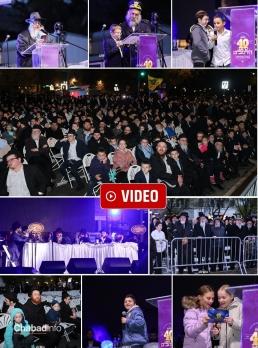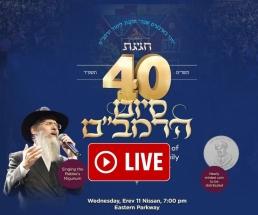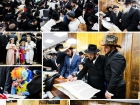Booklet Continues to Revolutionize Basi L’Gani Learning
Yad Menachem has released the next installment in their series of Umedayeik B’Maamar publications, by Rabbi Velvel Adler, which closely examines the exact Yiddish words that the Rebbe used when saying the Maamar Basi Legani 5723 • Full Story, Download
Yad Menachem has released the next installment in their series of Umedayeik B’Maamar publications, by Rabbi Velvel Adler, which closely examines the exact Yiddish words that the Rebbe used when saying the Maamar Basi Legani 5723.
Spanning over 175 pages, with more than 300 footnotes, this year’s Umedayeik B’Maamar highlights many new aspects of what the Rebbe said.
Here’s a sampling of what you can find inside:
Did you ever wonder why the Medrash interprets the word “Legani” to mean “Legenuni”? (see note 7)
Is this world a “Dira” for Hashem or only an “Ikar Dira” or are these both the same thing? (note 9)
Is “Ikar Shechina” always understood to be higher than “Shechina”? (notes 12, 35)
Why does the Rebbe mention “Adam Harishon” in Basi Legani 5723, as the beginning of the sins that caused the Shechina to depart, instead of “Chet Eitz Hadaas” as stated in Basi Legani 5710, and as the Rebbe has phrased it in his previous Basi Legani Maamorim? (note 16)
Avraham Avinu started to bring the Shechina back down. He also opened the channel of Mesiras Nefesh for all generations to come. Are these 2 connected? Was Yitzchok Avinu involved in opening this channel? Why are only Avraham and Yitzchok mentioned in Basi Legani 5710 as the Tzadikim who started bringing down the Shechina (before Moshe)? (notes 22, 23)
When did Moshe Rabbeinu bring the Shechina back down? By Matan Torah or when the Mishkan was erected? (notes 31, 32)
Why does the Rebbe mention that “V’Asu Li Mikdash” is a “Tzivui” (commandment), and why does it matter when the Tzivui took place? (note 33)
What does “V’Asu Li Mikdash, V’Shochanti Besocham – Besoch Kol Echad v’Echad” mean? What is inside each one of us “V’Asu Li Mikdash” or “V’Shochanti”? (notes 37, 324)
Why does the Rebbe mention two times that this Torah of the Baal Shem Tov is brought in Or Torah of the Maggid of Mezritch, and where does the Alter Rebbe bring this Torah? (notes 89, 92)
Does this particular Torah of the Baal Shem Tov have a special ability to bring Moshiach? Is there a connection between this and the letter that the Rebbe wrote on Yud Shevat 5723? (note 106)
Can there be a Halachic problem with explaining that the 3 floors of the Teivah correspond to the 3 worlds of Beriah, Yetzirah and Asiyah? Does the Rebbe deal with this issue? (notes 94, 97, 101)
Is there more than one “Baal Hilulah” on Yud Shevat? (notes 127, 159)
You can find these and many more ideas that the Rebbe included in Basi Legani 5723, in this year’s Umedayeik B’Maamar, which provides a unique opportunity to fulfill the Rebbe’s directive (Likutei Sichos vol. 21 p. 448 – free translation): “In order to understand the true intent of the “Divrei Torah” of our Rebbeim, it’s not sufficient to learn them as they have been translated into Loshon Hakodesh (Hebrew) by others, rather we must study the words that they said in Yiddish.”
Read:
42
Join ChabadInfo's News Roundup and alerts for the HOTTEST Chabad news and updates!











































